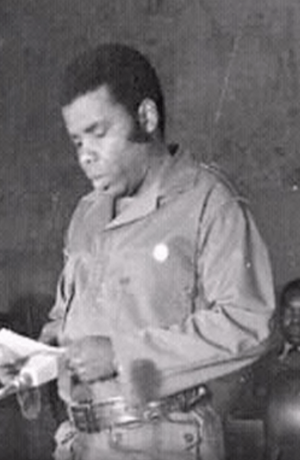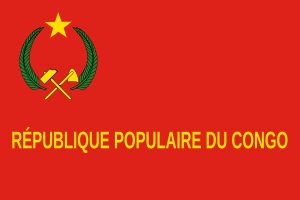Marien Ngouabi facts for kids
Quick facts for kids
Marien Ngouabi
|
|
|---|---|

Ngouabi in January 1970
|
|
| 4th President of the People's Republic of the Congo | |
| In office 1 January 1969 – 18 March 1977 |
|
| Vice President | Ange Diawara Aimé Portella Alfred Raoul Aloïse Moudileno-Massengo Ange-Édouard Poungui |
| Preceded by | Alfred Raoul |
| Succeeded by | Joachim Yhombi-Opango |
| Personal details | |
| Born | December 31, 1938 Ombellé, Cuvette, French Equatorial Africa |
| Died | March 18, 1977 (aged 38) Brazzaville, People's Republic of the Congo |
| Cause of death | Assassination |
| Political party | Congolese Party of Labor |
| Spouse | Clotilde Ngouabi |
| Alma mater | École spéciale militaire de Saint-Cyr |
| Military service | |
| Allegiance | |
| Rank | General of the army |
Marien Ngouabi (born December 31, 1938 – died March 18, 1977) was an important leader in the Republic of the Congo. He served as the fourth President of the country from January 1, 1969, until his death on March 18, 1977.
Contents
Early Life and Military Career
Growing Up
Marien Ngouabi was born in 1938 in a village called Ombellé. This village is located in the Cuvette Department of the Congo. He came from a family that did not have a lot of money.
From 1947 to 1953, he went to primary school in Owando. After that, in 1953, he moved to Brazzaville to study at a special military school for children. In 1957, he was sent to another military school in Bouar, which is now in the Central African Republic.
Joining the Army
Ngouabi served in Cameroon as a Sergeant from 1958 to 1960. He was part of the second battalion of soldiers called tirailleurs.
In September 1960, he went to France for more military training. He studied at the Ecole Militaire Préparatoire in Strasbourg. Then, in 1961, he attended the Ecole Inter-armes at Coëtquidan Saint-Cyr.
He returned to Congo in 1962 as a Second Lieutenant. He was stationed in Pointe-Noire. In 1963, he was promoted to the rank of Lieutenant.
Becoming President
Challenges and Leadership
In 1965, Ngouabi created the first group of paratroopers in the Congo Republic. He was known for his political ideas, which focused on equality and social change.
In 1966, he faced problems with the army leaders. He was demoted because he disagreed with their political ideas and spoke out against the president. On July 29, 1968, President Alphonse Massamba-Débat had Ngouabi arrested.
However, Ngouabi's arrest made many soldiers unhappy. On July 31, soldiers from the Civil Defense freed him. Soon after, on August 5, 1968, Ngouabi helped create a new group called the National Revolutionary Council (CNR). He became the leader of this council.
On October 1, 1968, he was promoted to Commanding Officer. This was the highest rank he held. President Massamba-Débat resigned on September 4. The CNR officially took control of the country on December 31, 1968. As the head of the CNR, Marien Ngouabi became the new President.
As Head of State
New Direction for the Country
Once he became president, Ngouabi made big changes. He renamed the country the People's Republic of the Congo. He declared it to be the first country in Africa to follow Marxism–Leninism. This is a political idea focused on a classless society.
He also founded the Congolese Workers' Party (PCT). This party became the only legal political party in the country.
Ngouabi was from the Koyo ethnic group in the north of the country. His government shifted power away from the southern parts of the country. This caused some disagreements, especially in Brazzaville.
Challenges to His Rule
During his time as president, Ngouabi faced several challenges. In 1971, students in Brazzaville and Pointe-Noire went on strike. The government responded strongly to these protests.
There was an attempt to remove him from power in February 1972. This led to the arrest of people who were seen as opposing the government. Some believed that France wanted Ngouabi to take control of the oil-rich Cabinda area. His refusal might have cost him French support.
In February 1973, the army began operations against a group called M22. This group was led by former Vice President Ange Diawara. Ngouabi also announced another attempt to remove him from power that month. Many people were arrested, including Pascal Lissouba.
The M22 group was stopped on April 24, 1973. In July 1973, Ngouabi visited the People's Republic of China.
Later Years as President
Ngouabi was re-elected as Chairman of the PCT Central Committee on December 30, 1974. He also became the Permanent Secretary of the PCT. He was sworn in for another term as president on January 9, 1975. In the same year, he signed an agreement for economic help with the Soviet Union.
On March 23, 1975, Lieutenant General Pierre Kinganga tried to overthrow the government. He had been living in exile in Kinshasa. His attempt failed, and he was killed near the national radio station. Several others involved were also punished. After this event, Marien Ngouabi said that the CIA and President Mobutu Sese Seko of Zaire were involved.
Following this attempt, the PCT held a special meeting. The Gendarmerie, a police force, was dissolved. Its members joined the army.
Assassination
On March 18, 1977, at 2:30 PM, President Ngouabi was killed. People accused of being involved in his death were put on trial. Some were executed, including former President Alphonse Massamba-Débat.
After his death, a group called the Military Committee of the Party (CMP) took over the government temporarily. Colonel Joachim Yhombi-Opango became the new Head of State.
Remembering Marien Ngouabi
March 18 is celebrated as Marien Ngouabi Day in the Republic of Congo. The country's only university is named the Marien Ngouabi University in Brazzaville. Ngouabi is buried at the Marien Ngouabi Mausoleum in Brazzaville.
See also
 In Spanish: Marien Ngouabi para niños
In Spanish: Marien Ngouabi para niños


